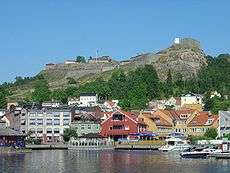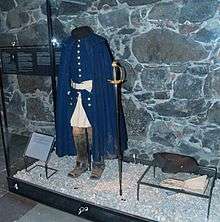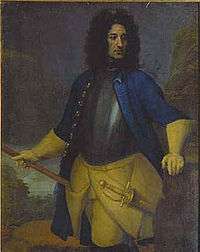Siege of Fredriksten
| Siege of Fredriksten | |||||||
|---|---|---|---|---|---|---|---|
| Part of Great Northern War | |||||||
 Fredriksten fortress as seen from the harbor. | |||||||
| |||||||
| Belligerents | |||||||
|
|
| ||||||
| Commanders and leaders | |||||||
|
Charles XII of Sweden † Carl Gustaf Armfeldt | Barthold Nicolai Landsberg | ||||||
| Strength | |||||||
| 6,000 | 1,800 | ||||||
| Casualties and losses | |||||||
| 200 including Charles | 9 dead, 10 wounded, 19 captives, 22 died of sickness, 41 escaped, 478 diseased. | ||||||
The Siege of Fredriksten (Beleiringen av Fredriksten festning) was an attack on the Norwegian fortress of Fredriksten in the city of Fredrikshald, (today Halden) by Charles XII of Sweden. While inspecting his troops' lines, Charles XII was killed by a projectile. The Swedes broke the siege off, and the Norwegians held the fortress.[1] Alongside with the Treaty of Nystad three years later, the death of Charles XII marked the end of the imperial era in Sweden, and the beginning of the Age of Liberty in that country. [2]

Background
King Charles XII of Sweden made several campaigns into the city during the Great Northern War as part of his campaign to capture Norway. At the close of the Great Northern War, the Norwegian Army had been weakened in early 1716 by withdrawal of 5000 of the best troops to Denmark. When rumors reached Christiania (now Oslo) that Charles XII was preparing to invade, all remaining troops in Østerdal and Gudbrandsdal were ordered to the border at Halden and Fredrikstad. The Norwegians expected the Swedes to invade at Kongsvinger, Basmo and/or Halden. It was at Basmo where Charles XII struck, crossing the border March 8, 1716. The Norwegian scorched earth policy and guerrilla raid interdiction of supply chains by the residents of Bohuslen deprived Charles of supplies, while the fortresses still held by the Norwegians behind his lines threatened his supply chain. Charles took Christiania, but without heavy siege artillery, was unable to take Akershus Fortress.[3]
After a brief occupation, Charles retraced his steps to the Norwegian fortresses in southeastern Norway with the objective of capturing Frederiksten. This would remove the threat at his back, and the fortifications could serve as the base for a renewed offensive later that year. Capturing the harbours at the mouth of the Glomma river would also allow him to land the necessary provisions for a successful siege of Akershus Fortress. [4]
Charles' troops attempted to take Frederiksten by storm on July 4th. His troops took the town after fierce fighting, but the citizens set fire to their own houses, forcing Charles, unable to take the fortress, to retreat and await the arrival of heavy siege guns. Unfortunately for the invading army the entire Swedish transport fleet was captured or destroyed by the Norwegian naval hero Peter Wessel Tordenskjold (1690-1720) at the Battle of Dynekilen (Slaget om Dynekilen) in Bohuslen. Running low on supplies, Charles retreated hastily across the Svinesund and burned the bridges behind him. By July 12, 1716 all Swedish troops had been withdrawn from the area around Fredriksten. [5] [6]
Siege of 1718
Charles came again to besiege the fortress in autumn of 1718 with 40,000 men. He did this intending to first capture Frederiksten to be able to sustain a siege of Akershus. By first taking the border areas, Charles wished to avoid a repeat of the fiasco he had suffered two years before. The 1,400 strong garrison of Frederiksten fought ferociously to hold back the invasion, but suffered a severe setback when, on December 8th the forward fortification Gyldenløve fort fell. Encouraged by their very hard-fought success the Swedish army intensified their efforts against the main fort. [7]
The Swedish trenches had almost reached the main fortification walls when on the evening of December 11th (Swedish calendar: November 30), 1718, a projectile struck and killed Charles XII through the left temple while he inspected the trench-works. The death of the king effectively ended the attack on Fredriksten and the invasion was called off, leading to the conclusion of the war. [8] [9]
Expedition by Carl Gustaf Armfeldt
Swedish General Carl Gustaf Armfeldt (1666–1736) tried to take the city of Trondheim via Fredriksten while the siege was still going on. Poorly equipped, Armfelt pulled out after the king fell at Fredrikhald. The ensuing disaster that struck his Carolean army is known as the Carolean Death March. On New Year's Eve 1718 he arrived at Tydal in Trøndelag with 80 kilometers to the closest Swedish village in Jämtland. [10] When the troops had marched 10 kilometers from Tydalen, a severe blizzard struck from the northwest. The bitter cold killed the guide on the very first day, and the army scatted blindly in the Sylan mountains. Over the following nights, hundreds more perished. Of the over 5,000 men who left Tydal, only 870 were found alive on arrival at Duved in Jämtland, mostly hardened Finnish veterans.[11][12]
References
- ↑ "De svenske invasjonene av Norge i 1716 og 1718". University of Oslo. Retrieved June 1, 2017.
- ↑ "Beleiringen av Fredriksten 1718". lokalhistoriewiki.no. Retrieved September 1, 2018.
- ↑ Erlend Hammer. "Akershus slott og festning". Store norske leksikon. Retrieved June 1, 2017.
- ↑ "Norge i den store nordiske krig". University of Oslo. Retrieved June 1, 2017.
- ↑ "Peter Wessel Tordenskjold". lokalhistoriewiki. Retrieved September 1, 2018.
- ↑ "1716 - Slaget om Dynekilen". Forsvarets Marinemuseet. Retrieved September 1, 2018.
- ↑ "Gyldenløve fort". lokalhistoriewiki. Retrieved September 1, 2018.
- ↑ "Karl XIIs død". lokalhistoriewiki.no. Retrieved September 1, 2018.
- ↑ "Fredriksten Fortress". Innovation Norway. Retrieved June 1, 2017.
- ↑ "1718-1719 Armfeldts karoliner". karoliner.com. Retrieved September 1, 2018.
- ↑ Magne Njåstad. "Carl Gustaf Armfelt". Store norske leksikon. Retrieved June 1, 2017.
- ↑ "Karolinerspelet i Tydal". karolinerspelet.no. Retrieved September 1, 2018.
Related reading
- Frost, Robert I. (2000) The Northern Wars, 1558-1721 (Longman Harlowd) ISBN 0-582-06429-5
- Lisk, Jill (1968) The Struggle for Supremacy in the Baltic 1600-1725 (Funk & Wagnalls)
- Stagg, Frank Noel (1956) East Norway and its Frontier (George Allen & Unwin, Ltd)
- Stiles, Andrina (1992) Sweden and the Baltic, 1523 - 1721 (Hodder & Stoughton) ISBN 0-340-54644-1
